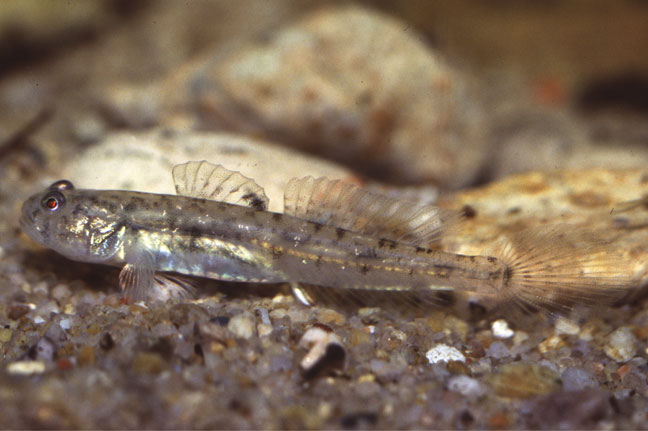Scary's Tasmangoby, Tasmanogobius lasti Hoese 1991

Scary's Tasmangoby, Tasmanogobius lasti. Source: Michael Hammer. License: All rights reserved
A tan to pale brown or greyish-white goby, with small scattered darker dots and blotches, a narrow vertical black bar from the eye to the rear of the mouth, alternating small and large black blotches (often vertically elongate) along the midside, two narrow vertical black bars on the side of the belly, and sometimes an indistinct black spot on the rear of the dorsal fin.
Scary's Tasmangoby, Tasmanogobius lasti Hoese 1991
More Info
|
Distribution |
Tambo River, Victoria, to Kangaroo Island, South Australia, throughout coastal Tasmania, and in freshwater to Lake Bonney, South Australia. Occurs in the Lower Murray-Darling Basin, where it is found in Lake Alexandrina, Lake Albert, and the Coorong, and a small distance upstream into the main channel and wetlands of the Lower Murray River. Inhabits muddy and silty-sand areas in bays, estuaries and in the lower reaches of streams, often extending well into freshwater. May burrow into the substrate. |
|
Features |
Dorsal fin VII-IX; 13-16; Anal fin 12-16; Caudal fin (segmented rays) 16-17, (branched rays) 13-17; Pectoral fin 16-20; Pelvic fin I, 5; Vertebrae 12-13 + 18-20 = 20-22; Gill rakers 1-3 + 4-7 = 5-10. Body slender, depth 15.3-16.4% SL. Head small, length 3.6-3.9 in SL, slightly compressed Anterior nostril at end of short tube, about midway between upper margin of upper lip and eye, about 2 nostril diameters above upper lip; posterior nostril with raised rim, immediately before anterior margin of eye and above and behind anterior nostril. Eye about equal to snout in adults. Mouth small and oblique; reaching to below middle of eye in male and below anterior quarter of pupil in female; teeth in upper jaw conical, outer row teeth close-set; second row of smaller teeth anteriorly; lower jaw teeth similar to upper jaw teeth, but with outer row teeth more wide-set; tongue tip truncate to slightly emarginate. Gill opening restricted to pectoral base; gill rakers short. At least 5 lateralis system open head pores. Body partly scaled; vertically elongate scales behind pectoral base on sides of belly usually continuous with posterior body scales; Body scales largely ctenoid; lateral line absent; longitudinal series 29-47. Pectoral base, prepelvic area and midline of belly naked; posterior portion of body completely scaled; scale coverage becoming reduced anteriorly, with naked patch beginning below and near front of second dorsal fin, with scale coverage narrowest between dorsal fins and below posterior end of first dorsal fin, coverage broadening anteriorly near pectoral insertion; belly naked or sometimes scaled on sides. Two dorsal fins; first dorsal fin long based with low rounded margin; membrane from end of first dorsal fin reaching near, but not to second dorsal origin; dorsal and anal fins typically with first ray unsegmented. Pectoral fin with rounded margin, reaching to below middle of first dorsal fin. Pelvic fins fused to form large cup-shaped disc reaching to just beyond middle of first dorsal fin, well short of anus. |
|
Size |
Males reach 3.6 cm SL, and regularly to 2.5 cm, females to 4.1 cm SL, and regularly to 3.0 cm. |
|
Colour |
Translucent pale brown with scattered, irregularly shaped black spots dorsally on body; 2-3 vertical black bars below first dorsal fin, extending onto sides of belly; midside with 4 more-or-less rectangular large black spots, first below second dorsal origin and fourth at posterior end of caudal peduncle; smaller, vertically elongate or rounded black spot, midway between each pair of rectangular spots; belly white to silvery; pectoral base pale brown to yellow, with small black spot dorsally near base of fin rays. Head with many scattered melanophores; thin black bar from ventral margin of eye to posterior end of jaws; diffuse grey spot behind eye and another at dorsoposterior margin of operculum; cranium behind eye with dense subcutaneous concentration of melanophores. Fins transparent. First dorsal fin with small dark spots forming 23 horizontal black stripes, males with intense black pigment, usually forming black bar between last 2-3 dorsal spines, pale to grey posteriorly in females.; second dorsal with dark spots forming 3-5 oblique stripes; anal fin without pigment; caudal fin with 2-4 wavy black bars; pelvic and pectoral fin with scattered black flecks. |
|
Biology |
Females spawn demersal eggs, and the species may breed in freshwater. |
|
Etymology |
The specific name honors Peter Last, CSIRO Division of Fisheries, Hobart, who supplied much of the Tasmanian material for the description of this species. |
|
Species Citation |
Tasmanogobius lasti Hoese 1991, Memoirs of Museum Victoria 52(2): 366, figs 5–7. Type locality: Princetown, Victoria. |
|
Author |
Gomon, M.F. & Bray, D.J. 2025 |
|
Resources |
Scary's Tasmangoby, Tasmanogobius lasti Hoese 1991
References
Hammer, M.P. & Walker, K.F. 2004. A catalogue of South Australian freshwater fishes, including new records, range extensions and translocations. Transactions of the Royal Society of South Australia 128(2): 85-97
Hoese, D.F. 1991. A revision of the temperate Australian gobiid (Gobioidei) fish genus Tasmanogobius with a comment on the genus Kimberleyeleotris. Memoirs of Museum Victoria 52(2): 361-376 figs 1-10 https://doi.org/10.24199/j.mmv.1991.52.13, open access
Hoese, D.F. & Larson, H.K. 1994. Family Gobiidae. pp. 781-810, figs 690-714 in Gomon, M.F., Glover, C.J.M. & Kuiter, R.H. (eds). The Fishes of Australia's South Coast. Adelaide : State Printer 992 pp. 810 figs.
Hoese, D.F. & Larson, H.K. 2008. Family Gobiidae. pp. 749-773 in Gomon, M.F., Bray, D.J. & Kuiter, R.H. (eds). Fishes of Australia's Southern Coast. Sydney : Reed New Holland 928 pp.
Larson, H. & Goatley, C. 2025. Tasmanogobius lasti. The IUCN Red List of Threatened Species 2025: e.T241146973A241146975. Accessed on 28 May 2025.
Last, P.R., Scott, E.O.G. & Talbot, F.H. 1983. Fishes of Tasmania. Hobart : Tasmanian Fisheries Development Authority 563 pp. figs (as Tasmanogobius sp. 2).
Lintermans, M. 2007. Fishes of the Murray-Darling Basin — an introductory guide. Canberra : Murray-Darling Basin Commission Vol. MDBC Publication Number 10/07 157 pp.




